The AMD Radeon RX 480 Preview: Polaris Makes Its Mainstream Mark
by Ryan Smith on June 29, 2016 9:00 AM ESTPower, Temperature, & Noise
Given AMD’s focus on power efficiency with Polaris – not to mention the overall benefits of the move to 14nm FinFET – there is a lot of interest in just how the RX 480 stacks up when it comes to power, temperature, and noise. So without further ado…

When it comes to idle power consumption I'm posting the results I've measured as-is, but I want to note that I have low confidence in these results for the AMD cards. Ever since the GPU testbed was updated from Windows 8.1 to Windows 10, AMD cards have idled 3-5W higher than they used to under Windows 8.1. I believe that this is an AMD driver bug – NVIDIA’s cards clearly have no problem – possibly related to the GPU tested being an Ivy Bridge-E system. In this case I don’t believe RX 480’s idle power consumption is any higher than GTX 960’s, but for the moment the testbed is unable to prove it.
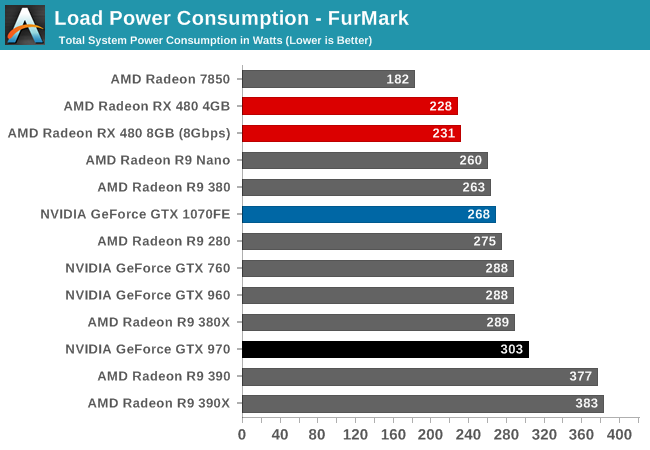
Traditionally we start with gaming load power before moving on to FurMark, but in this instance I want to flip that. As a power virus type workload, FurMark’s power requirements are greater than any game. But because it’s synthetic, it gives us a cleaner look at just GPU power consumption.
Among AMD’s cards, the RX 480 is second to only the Radeon HD 7850 in power consumption. Even then, as a GCN 1.0 card, the 7850 is one of the last AMD cards without fine-grained power states, so this isn’t a true apples-to-apples comparison. Instead a better point of reference is the GCN 1.2 based R9 Nano, which has a 175W TBP. Compared to the R9 Nano we find that the RX 480 draws about 30W less at the wall, which almost perfectly translates to the 25W difference in TBP. As a result we can see first-hand the progress AMD has made on containing power consumption with Polaris.
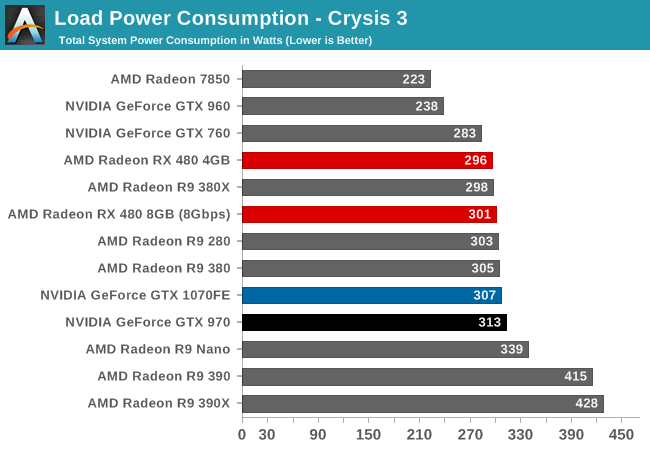
However things are a bit more mixed under Crysis 3. RX 480 is still near the top of our charts, and keeping in mind that higher performing cards draw more power on this test due to the additional CPU workload, the RX 480 compares very favorably to the rest of AMD’s lineup. System power consumption is very close to R9 280/380 for much improved performance, and against the performance-comparable R9 390, we’re looking at over 110W in savings. Hawaii was a solid chip from a performance standpoint, and Polaris 10 picks up where that left off by bringing down the power consumption to much lower levels.
The drawback for AMD here is that power consumption compared to NVIDIA still isn’t great. At the wall, RX 480 is only about 10W ahead of the performance-comparable GTX 970, a last-generation 28nm card. 1070FE further complicates matters, as its performance is well ahead of RX 480, and yet its power consumption at the wall is within several watts of AMD’s latest card. Given what we saw with FurMark I have little reason to believe that card-level power consumption is this close, but it looks like AMD is losing out elsewhere; possibly with driver-related CPU load.
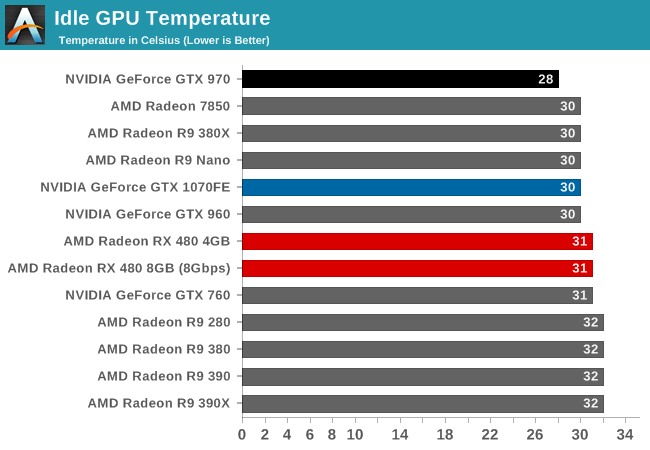
Moving on to idle GPU temperatures, there’s little to remark on. At 31C, the RX 480’s blower based design is consistent with the other cards in our lineup.
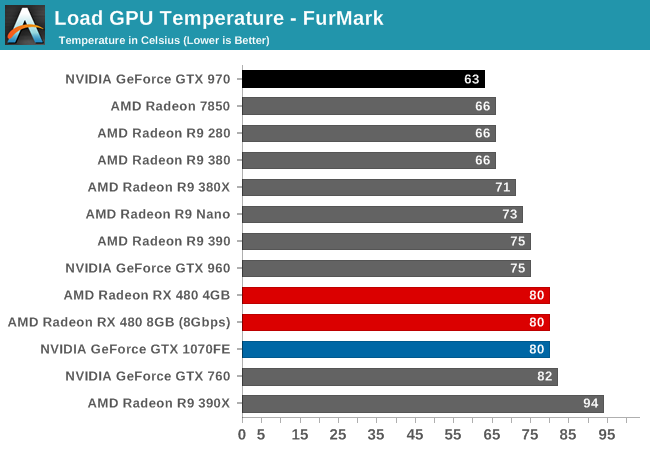
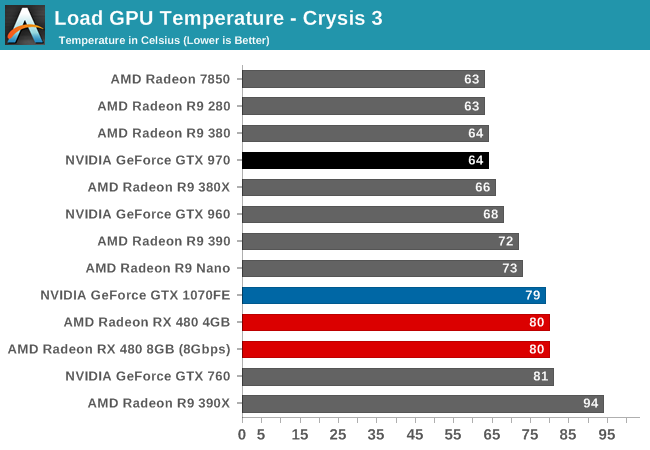
Meanwhile with load temperatures, we get to see the full impact of AMD’s new WattMan power management technology. The RX 480 has a temperature target of 80C, and it dutifully ramps up the fan to ensure it doesn’t exceed that temperature.

With idle noise levels RX 480 once again posts a good result. At 37.8dB, it’s in good company, only meaningfully trailing cards that idle silently due to their respective zero fan speed idle implementations.
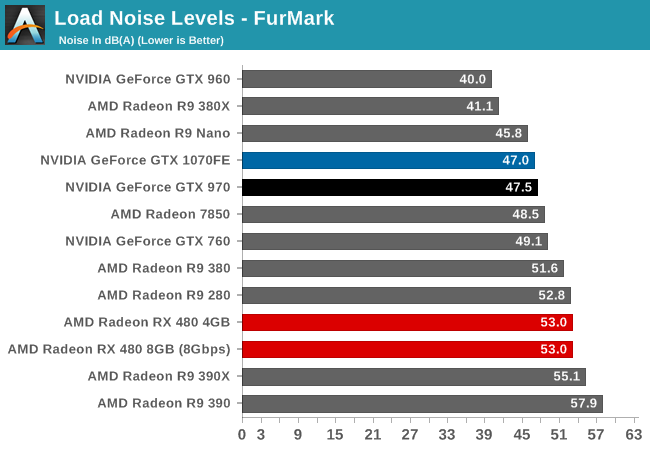
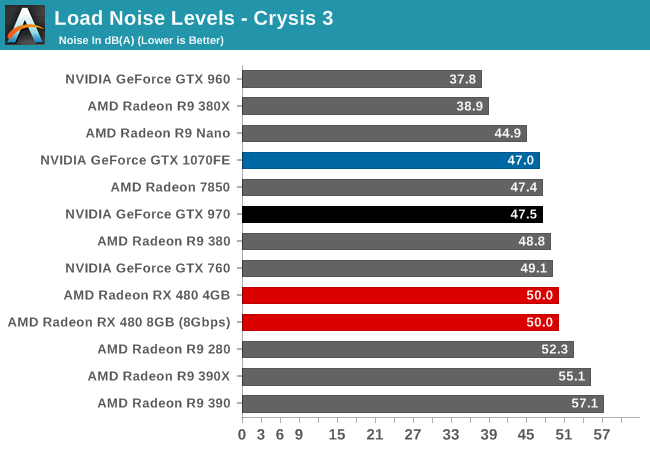
Finally, with load noise levels, RX 480 produces middling (but acceptable) results. Given that we have a mix of blowers and open air coolers here, the RX 480 performs similarly to other mainstream blower based cards. The $199 price tag means that AMD can’t implement any exotic cooling or noise reduction technologies, though strictly speaking it doesn’t need them.










449 Comments
View All Comments
Chris A. - Wednesday, June 29, 2016 - link
To replace my 7850 on my 1080p monitors maxed out at 60 Hz, it's an absolute winner.proxopspete - Wednesday, June 29, 2016 - link
That's where I am... just need a non-stock coolercatavalon21 - Wednesday, June 29, 2016 - link
I too have the 7850. I still would like to see some basic compute numbers for both, but yeah, this would handily fill the role for gaming...SunnyNW - Wednesday, June 29, 2016 - link
Others with 7850s...Did you notice that the FPS numbers for the 7850 seemed a little on the low side... Going back and testing I easily get around 30 fps at 1080p in the games where it was showing in the 20s. Does the choice of OS make a performance difference? Between Win 7/8/10?Laxaa - Thursday, June 30, 2016 - link
Same here. Now I'm debating if it's wise to go with the 8GB version, or if I should spring for the 4GB one and save money. I'll eventually get a 4K display, but that will mostly be because of work.HollyDOL - Wednesday, June 29, 2016 - link
eww, that's not really stellar, given the charts now GTX-1060 will likely have it for breakfast...D. Lister - Wednesday, June 29, 2016 - link
If I were Nvidia, at this point I would probably take half a 1070, factory-OC the bejeezus out of it, add 6GB gddr5, slap on a $150 MSRP and call it a day. :pChris A. - Wednesday, June 29, 2016 - link
Remember that die size on the 1070 is 40-50% larger than the RX480, so their margin is going to be smaller to reach that price point.Yojimbo - Thursday, June 30, 2016 - link
Yeah there's no reason to use GP104 when they have GP106 for that purpose.Ananke - Wednesday, June 29, 2016 - link
NVidia has never in its history "slapped" $150 when they can put $300 price tag. At best, whenever such thing as GTX1050 happen, it may be around $200 mark for half of this performance. NVidia will never cannibalize its prices, they sell their 1070/1080 with markup easily anyway. There is no reason for them to not have markup on 1060/1050 as well.